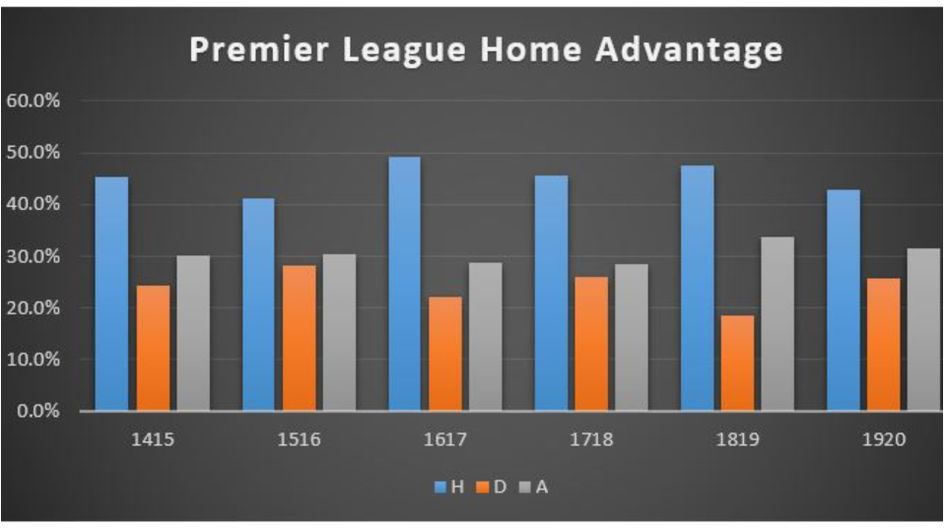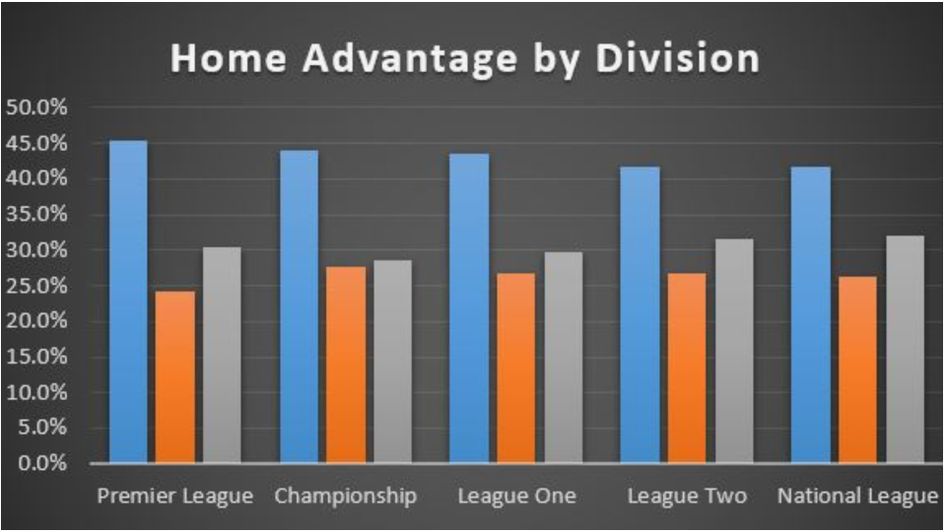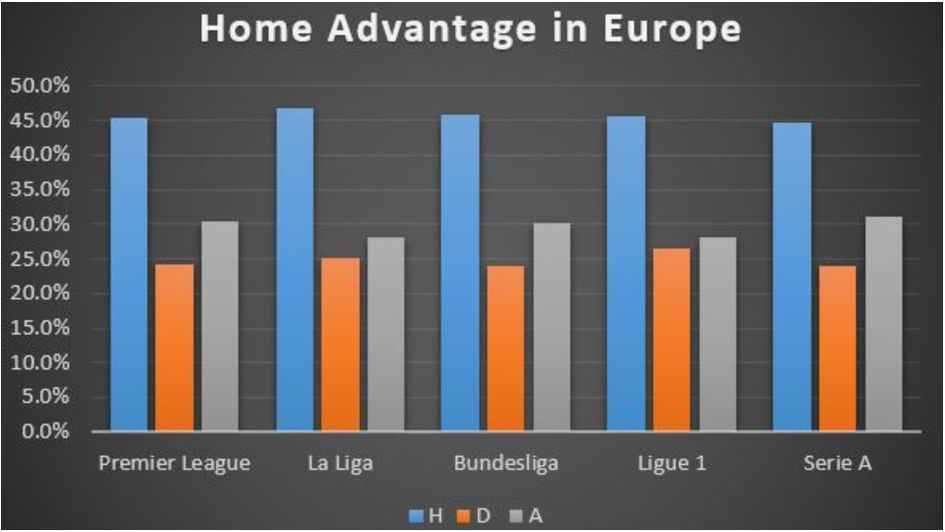With neutral venues being discussed by the Premier League, Dave Pilgrim digs deep into the stats to see if playing at home really is an advantage.
Plans for football to return have been gathering a head of steam, with the Bundesliga set to return; and continued talks within the Premier League discussing a variety of options for them to return to action. Those options include playing behind closed doors or potentially at neutral venues in a bid to save themselves from years of potential litigation that they seemingly fear more than the health risks posed by COVID-19 itself.
It’s looks certain that, if and when football does return in England, it will do so without fans – initially at least. As punters, it’s therefore time for us to have a little think about what that means.
Home Advantage Matters
Let’s start with the basics. We know home advantage matters – you only have to look at the win-rates of matches over the long term. In the Premier League for example, two equal teams facing off would typically leave us expecting the home team to triumph around 45.5% of the time, whereas the away side would win just 30.5%. It’s a predictable pattern repeated season on season.

That home-bias is also something the Football League have recognised with their latest thinking centred around weighted points per game taking into account home and away fixtures played.
Is the Premier League home advantage typical?
Yes and No is the simple answer. Looking at the past six season’s of result gives us a decent sample to analyse, and it tends to suggest that the bigger divisions in England do enjoy a stronger home advantage – albeit only marginally. The Premier League tops out at 45.4%, dropping to 43.9% in the Championship and then down to 43% in League One and 41.6% in each of League Two and the National League.

When we expand the comparison to overseas competitions, including the top divisions in Spain, Germany, Italy and France there is a strong argument that the pattern seen in England is likely down to stadium size and attendances. The trends are as close as they could possibly be between each of Europe’s five marque domestic leagues.

What might cause home advantage?
Aston Villa chief executive Christian Purslow this week said his club would not support the Premier League proposal to play remaining matches at neutral venues – citing Villa as a “club that prides itself on home form. Two-thirds of our wins this season have come at home”. It was no surprise to see him take that stance, but it was nothing to do with Villa especially over or under-achieving at home – the typical joe-ordinary club will achieve 60% of their wins on home soil. Villa just have more of those games still on the fixture list.
What was interesting in Villa’s position, given the context of the conversation, is that they clearly do attribute a decent advantage to playing their remain fixtures on a home and away basis, even in the absence of fans. It’s logical to hypothesise that a combination of familiar surroundings and absence of travel are key to this thinking.
Historically, it’s a commonly applied disciplinary process to see sides punished for indiscretions by forcing them to play without fans. It’s unclear whether that punishment is meant to reduce a club's chances of winning, hit them in the pocket by cutting off gate-receipts or as a means to ensure fans take behavioural issues seriously through the upset of not being able to watch their side. We certainly cannot deduce that governing bodies categorically believe sides playing without fans are less likely to win, although it seems a reasonable assertion.
Further, we can only hypothesise as to what constitutes the clear and proven advantage that playing at home delivers. The popular argument would be that the screaming fans and the support they generate motivates the players to work harder, run further and reach their potential more frequently. It’s certainly a good one, but Purlsow’s (and others) stance suggests that’s only part of the picture.
Could the comfort that familiarity brings be equally important? From knowing where you always park your car, the Friday into Saturday routine and the familiar faces from the ground staff might also play an important role at putting players at ease.
A tour of Stamford Bridge once showed me a truly horrific away dressing room set-up which ensured that the regulation tactics board had been carefully mounted directly behind a series of doors for maximum inconvenience.
The distances travelled by away teams is another often suggested reason for why away teams under-perform, although research in the past has tended to largely disprove this – with there being negligible correlation between distance travelled and away team chance of success.
Perhaps it is the unconscious referee bias? Although almost certainly a phenomena, it’s hard to reason this one. With large crowds at higher profile leagues, you would expect (and do observe) a stronger home bias. I’d counter this argument though with the suggestion that a top-level referee would place far greater importance on the post-match television scrutiny under which their decisions will be subjected to, which is surely more important than a crowd jeering at you.
The Bundesliga Model
The Bundesliga have agreed to come back with matches played at the originally planned locations, but without fans in attendance. For my money, at the chosen model is likely to result in a proportional shift towards greater away wins, and fewer home wins. It’s something I believe we need to build into our pricing calculations immediately, but I don’t expect substantive differences to occur.
We know that a home team wins in Germany roughly 45% of the time, with a draw occurring around 24% of the time, and an away win just over 30%. That means, in a typical match, with no margin, we would be looking at odds of around 6/5 for a home win, 16/5 for the away win and 9/4 for the away side.
Assuming that the draw rate remains constant, which seems reasonable, we would expect a match played on a truly neutral venue to result in a “home” win around 38% of the time, a draw 24% of the time and an “away” win around 38% of the time – using home and away purely as the designated teams. In other words, around 13/8, 16/5 and 13/8.
So without fans, the question we need to ask is simply “In a game of two equal sides, where should I sit on the scale 45% home wins (usual scenario) to 38% home wins (home bias entirely eroded).
That rhetoric about hordes of screaming fans ultimately helping shape the outcome of a match is romantic, and I’m sure we all want to believe we’re part of that home winning scenario, but any reasonable person must surely arrive at the conclusion that this is really only a small part of the picture. In a game of such fine margins, that occasional penalty call which the home team gets, but the away team misses out on might be crucial of course, so I’m not looking to belittle it, but the reality is that it is just one small aspect in a game of marginal gains.
Glancing back at the similarity of the home advantage all the way from Premier League down to National League tends to support that view. There is next to no discernible difference to home advantage between a league averaging 2000 fans per game, and one where the average attendance is over 30,000.
Conclusion
While predicting exactly where home advantage might end up, I’m going to have a stab based on the fixed points we know, and all the factors we’ve considered.
Usual circumstances in top European Leagues
- Home Win = 45.75%
- Draw = 24.5%
- Away Win= 29.75%
Neutral Venue Model
- Home Win = 37.75%
- Draw = 24.5%
- Away Win= 37.75%
Behind Closed Doors Model
- Home Win = ~42%
- Draw = 24.5%
- Away Win= ~33.5%
Follow Sporting Life on social - find us on Facebook here or tweet @SportingLifeFC
Related Bundesliga content
- Inside the Bundesliga title race
- Bundesliga scouting report
- Bundesliga Team of the Season
- Quiz: Guess the Bundesliga kits
- Five predictions for the remainder of the season
- Nine key Bundesliga fixtures
- Bundesliga: 5 Brits who made a mark
- In Profile: What has happened to Philippe Coutinho?
- In Profile: Enjoying the Sancho ride
- In Profile: Just how good is Erling Haaland?
Responsible gambling
We are committed in our support of responsible gambling. Recommended bets are advised to over-18s and we strongly encourage readers to wager only what they can afford to lose.
Sky Bet's responsible gambling tools are detailed here and if you are concerned about your gambling, please call the National Gambling Helpline on 0808 8020 133, or visit begambleaware.org.
Further support and information can be found at GamCare and gamblingtherapy.org.









